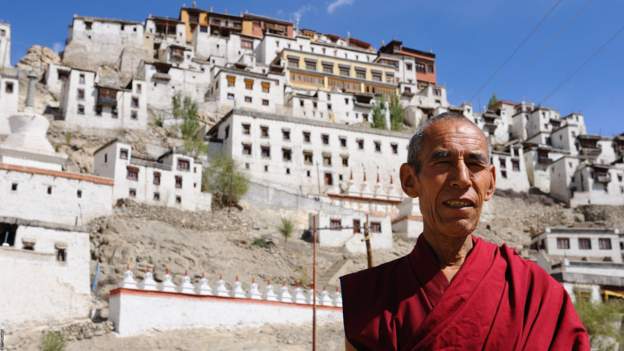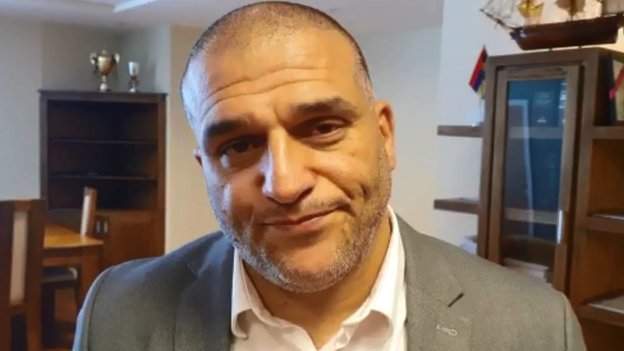| Venue: The Oval Date: 7-11 June |
| Coverage: Live Test Match Special commentary on BBC Radio 5 Sports Extra & BBC Sounds, plus the in-play video clips (UK only) and text commentary on the BBC Sport website and app. |
Legendary Australia captain Steve Waugh once said cricket is a religion in India, with former batter Sachin Tendulkar its God.
But what happens when religion actually meets cricket?
Up in the foothills of the Himalayas, far from the sprawling cities of some of the most populous cities on earth, a group of Tibetan monks brave freezing temperatures, sparse populations and rugged landscapes to play cricket.
The reason?
“We have to concentrate on our prayers so cricket is a release,” says Stanzin Namgail, one of the monks who lives in Thikse Monastery in Ladakh.
“Cricket here in Ladakh and for us monks is special. It’s like a celebration for us.”
Monks from the monastery started playing cricket after forming a relationship with Skalzang Kalyan Dorjey, a cricketer who became the first from the region to play in India’s premier domestic T20 league.
“Cricket is everything to me,” Dorjey told BBC Sport. “Cricket is my life.”
However, getting enough people interested in the sport to form a team and play in competitions hasn’t always been easy in Ladakh, meaning Dorjey’s special link-up with the monastery has been transformational.
‘Once the cricket comes we forget the religion’
The skillset and knowledge of the monks wasn’t immediately evident, but for Dorjey the end experience makes it worthwhile.
“We get whatever we are looking for, whether it is a bowler or batter, from the monastery,” Dorjey, who works as a tour guide, said.
“They have no specific skills or technique but they are so passionate and they want to play.
“Once the cricket tournament comes we forget the religion. Whether they are monks, a Muslim, a Hindu or a Buddhist – it doesn’t count. We are a team. Nobody gets any specialist treatment.”
It was a feeling that Namgail reiterated.
“We undertake our duties, the prayers and then go and play gully cricket,” he said. “It’s not an easy way to play due to the terrain but we organise our batting and fielding. The losing team has to clean the monastery and cook dinner!”

What a day in the monastery looks like
4am: Wake up before a wash, prayers, 10 minutes of meditation and a walk outside
6am: Pray for two hours
8-8:30am: Breakfast
9am-12pm: Prayers, followed by classes in science, Hindi, English and social
12-1pm: Lunch
1-2pm: Free time
2-4pm: More classes
4-6pm: Tea with a snack, followed by games, including cricket
6:30-9:30pm: Dinner followed by prayers
9:30pm: Bed
The monks play for two or three hours, either side of lunch at 12, on Sunday’s.

‘In winter we play on ice and it can be -25 degrees’
There are substantial issues and challenges to playing cricket in the region with the facilities still at a basic level.
“We have a concrete pitch and we just put a mat on top and we use the same hard, leather ball,” explains Dorjey, whose favourite player is former India all-rounder Yuvraj Singh.
“I play all over Ladakh. Sometimes I have travelled 230km. I woke up at 3am and played a game at 9am and then I would come back. I don’t miss any tournaments.”
The weather is also not always the sort cricket would traditionally be played in.
“In the winter we play on ice, it’ll be snowing on the side and we still play,” added Dorjey.
“There will a tournament in January and the winter is hard then. The temperature will be around -20 to -25 degrees celsius. We put a downjacket on and put our uniform on top.
“We just wish the ball does not come to us, ‘pleaseee don’t chip it near us’ but at the same time everyone puts their body on the line.”
Namgail, who supports five-time IPL winners Mumbai Indians, also tries to play cricket as much as possible and said the team originally “just chopped some wood” to make their own bats.
“Cricket is now part of our everyday routine,” he said.
“We have a strict routine as monks in the monastery but from 4-6pm we have games sessions. Everyone wants to be in the cricket team, if they don’t get the chance they get upset and angry.
“Our seniors understand the physical and mental benefits.”




















